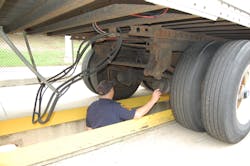During the week of Sept. 11-17, 2016, law enforcement agencies across North America will conduct inspections on large trucks and buses to identify out-of-adjustment brakes, and brake-system and anti-lock braking system (ABS) violations as part of the Commercial Vehicle Safety Alliance’s (CVSA) Brake Safety Week, an annual outreach and enforcement campaign designed to improve commercial motor vehicle (CMV) brake safety throughout North America.
“Properly functioning brake systems are crucial to safe CMV operation,” the agency said. “CMV brakes are designed to hold up under tough conditions, but they must be routinely inspected and maintained carefully and consistently so they operate and perform properly throughout the vehicle’s life. Improperly installed or poorly maintained brake systems can reduce braking efficiency and increase the stopping distance of trucks and buses, posing serious risks to driver and public safety. ABS systems help the vehicle, and thus the driver, maintain control in certain situations, which reduces the risk of some types of crashes.”
Read more:
Five critical tips for Brake Safety Week
How to prepare for CVSA’s Brake Safety Week
CVSA noted that brake-related violations comprised the largest percentage (representing 43%) of all out-of-service violations cited during Operation Airbrake’s companion International Roadcheck campaign in 2015, which focused on inspections of both vehicles and drivers.
Inspections conducted during Brake Safety Week include inspection of brake-system components to identify loose or missing parts, air or hydraulic fluid leaks, worn linings, pads, drums or rotors, and other faulty brake-system components. ABS malfunction indicator lamps are also checked. Inspectors will inspect brake components and measure pushrod stroke where applicable. Defective or out-of-adjustment brakes will result in the vehicle being placed out of service.
Many inspectors will be conducting Level I Inspections, and in the 10 jurisdictions currently using performance-based brake testing (PBBT) equipment, vehicle braking efficiency will be measured. These systems include a slow speed roller dynamometer that measures total vehicle weight and total brake force from which braking efficiency is determined. The minimum braking efficiency for trucks is 43.5 percent, required by U.S. federal regulation and the CVSA out-of-service criteria.
Outreach and educational efforts by CMV inspectors, participating motor carriers and others in the industry will also take place during Brake Safety Week and are integral to the success of the campaign.
More than 3.4 million brakes have been inspected since the program’s inception in 1998, the agency said. Brake Safety Week is part of the Operation Airbrake program sponsored by CVSA in partnership with the U.S. Department of Transportation’s Federal Motor Carrier Safety Administration.
About the Author
Fleet Owner Staff
Our Editorial Team
Kevin Jones, Editorial Director, Commercial Vehicle Group
Cristina Commendatore, Executive Editor
Scott Achelpohl, Managing Editor
Josh Fisher, Senior Editor
Catharine Conway, Digital Editor
Eric Van Egeren, Art Director
